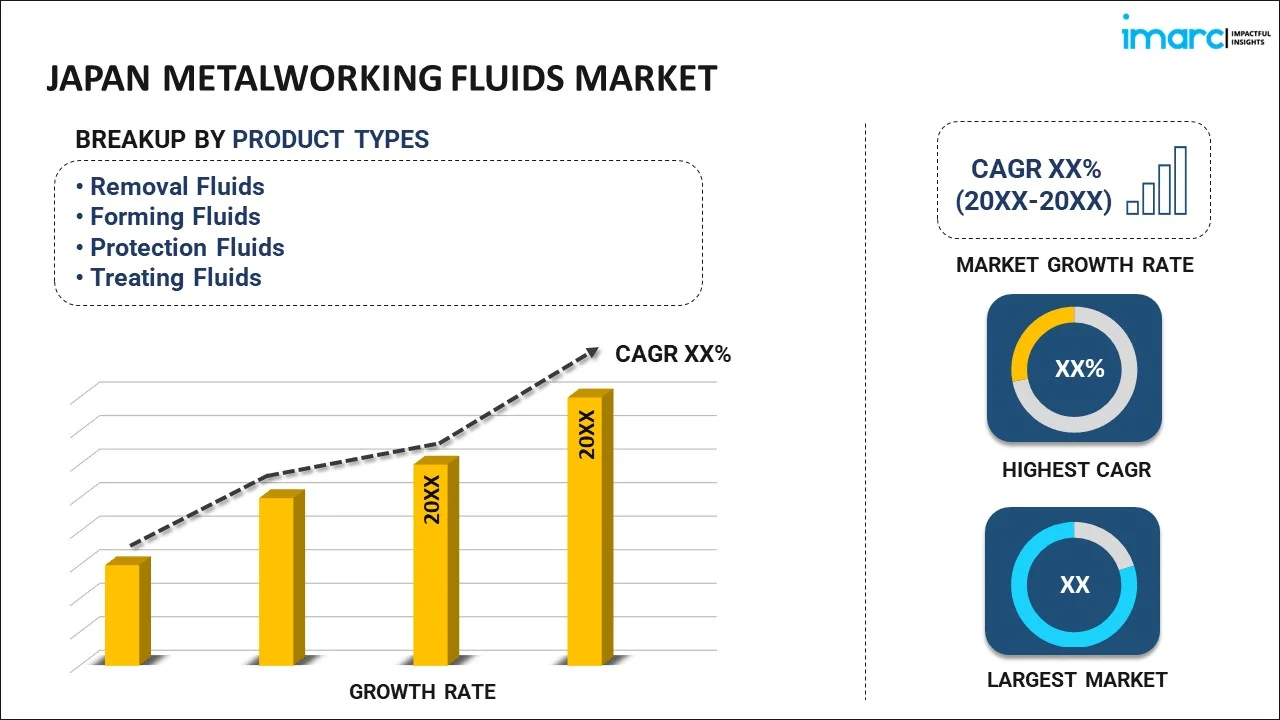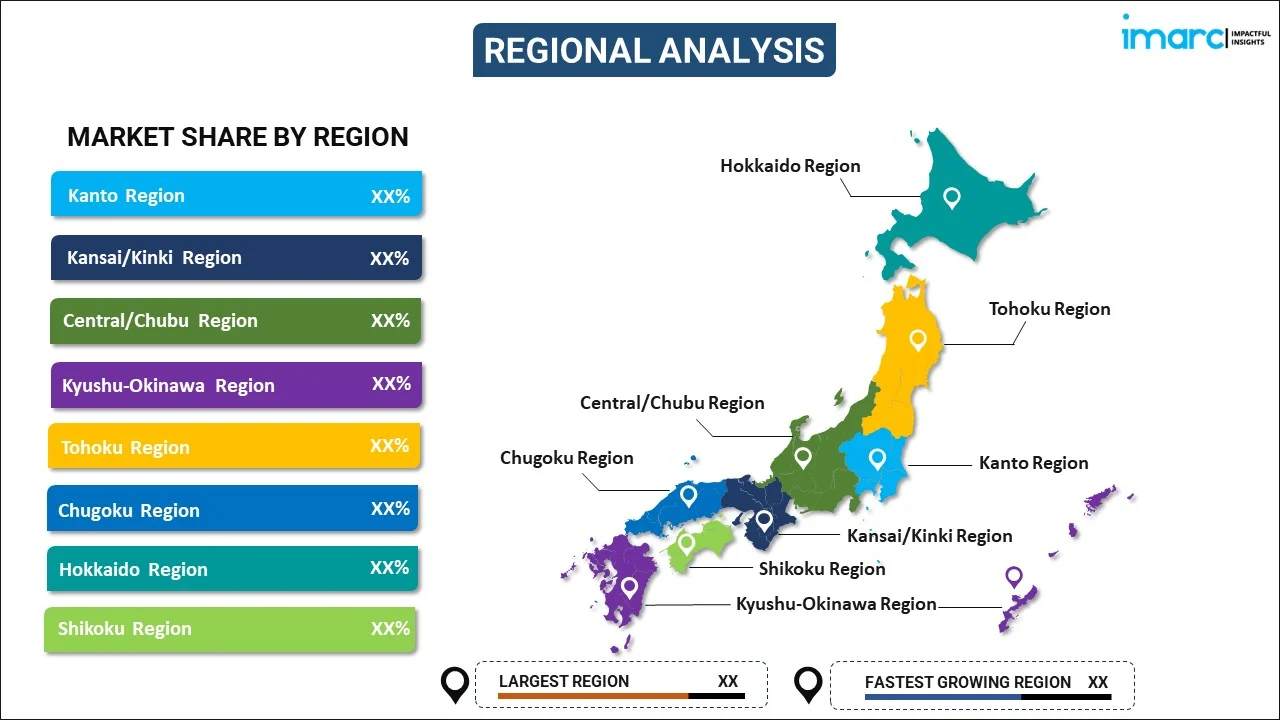
Japan Metalworking Fluids Market Report by Product Type (Removal Fluids, Forming Fluids, Protection Fluids, Treating Fluids), Source (Mineral, Synthetic, Bio-Based), End Use (Transportation Equipment, Machinery, Primary Metals, Fabricated Metal Products, Metal Cans, and Others), Fluid Type (Neat Cutting Oils, Water Cutting Oils, Corrosion Preventive Oils, and Others), Industry (Construction, Electrical and Power, Agriculture, Automobile, Aerospace, and Others), and Region 2025-2033
Market Overview:
Japan metalworking fluids market size reached USD 692.0 Million in 2024. Looking forward, IMARC Group expects the market to reach USD 821.1 Million by 2033, exhibiting a growth rate (CAGR) of 1.9% during 2025-2033. The increasing development of advanced machining and metalworking techniques, which require specialized metalworking fluids that can provide high-performance lubrication, cooling, and corrosion protection, is driving the market.
|
Report Attribute
|
Key Statistics
|
|---|---|
|
Base Year
|
2024 |
|
Forecast Years
|
2025-2033
|
|
Historical Years
|
2019-2024
|
| Market Size in 2024 | USD 692.0 Million |
| Market Forecast in 2033 | USD 821.1 Million |
| Market Growth Rate (2025-2033) | 1.9% |
Metalworking fluids (MWFs), also known as cutting fluids or coolant fluids, are essential substances used in various industrial processes to enhance the machining and shaping of metals. These fluids serve multiple purposes, including cooling, lubrication, chip removal, and corrosion prevention during metalworking operations such as cutting, milling, drilling, and grinding. MWFs dissipate heat generated during metal cutting, preventing the workpiece and tool from overheating and maintaining dimensional accuracy. They also reduce friction between the cutting tool and workpiece, which enhances tool life and improves machining efficiency. Additionally, metalworking fluids aid in chip evacuation, ensuring a cleaner working environment and preventing tool damage. Furthermore, MWFs act as a barrier against corrosion, safeguarding the workpiece and cutting tools from rust and oxidation. They come in various formulations, including oils, emulsions, synthetics, and semi-synthetics, each tailored to specific machining applications. Effective selection and management of metalworking fluids are crucial for maintaining productivity, tool life, and workpiece quality while minimizing environmental impact and health risks associated with their use.
Japan Metalworking Fluids Market Trends:
The metalworking fluids market in Japan is poised for significant growth in the coming years due to several key drivers. Firstly, the increasing demand for precision-engineered components in industries such as automotive, aerospace, and electronics necessitates advanced machining processes, thereby boosting the demand for metalworking fluids. Additionally, the rising adoption of CNC (computer numerical control) machines and automation in manufacturing facilities enhances the need for high-performance cutting and lubricating fluids, driving market expansion. Furthermore, stringent environmental regulations are pushing manufacturers to adopt eco-friendly metalworking fluids that reduce emissions and waste generation. This shift towards sustainable practices is not only in compliance with regulatory requirements but also aligns with the growing environmental consciousness among consumers. Moreover, the growing industrialization and infrastructure development are driving the metalworking fluids market. This creates a substantial market opportunity for metalworking fluid manufacturers and suppliers to cater to the burgeoning demand. In conclusion, the metalworking fluids market in Japan is expected to be driven by factors such as increased precision requirements, automation, environmental concerns, and rapid industrialization.
Japan Metalworking Fluids Market Segmentation:
IMARC Group provides an analysis of the key trends in each segment of the market, along with forecasts at the country level for 2025-2033. Our report has categorized the market based on product type, source, end use, fluid type, and industry.
Product Type Insights:

- Removal Fluids
- Forming Fluids
- Protection Fluids
- Treating Fluids
The report has provided a detailed breakup and analysis of the market based on the product type. This includes removal fluids, forming fluids, protection fluids, and treating fluids.
Source Insights:
- Mineral
- Synthetic
- Bio-Based
A detailed breakup and analysis of the market based on the source have also been provided in the report. This includes mineral, synthetic, and bio-based.
End Use Insights:
- Transportation Equipment
- Machinery
- Primary Metals
- Fabricated Metal Products
- Metal Cans
- Others
The report has provided a detailed breakup and analysis of the market based on the end use. This includes transportation equipment, machinery, primary metals, fabricated metal products, metal cans, and others.
Fluid Type Insights:
- Neat Cutting Oils
- Water Cutting Oils
- Soluble Cutting Oils
- Semi-synthetic Cutting Oils
- Synthetic Cutting Oils
- Corrosion Preventive Oils
- Others
A detailed breakup and analysis of the market based on the fluid type have also been provided in the report. This includes neat cutting oils, water cutting oils (soluble cutting oils, semi-synthetic cutting oils, and synthetic cutting oils), corrosion preventive oils, and others.
Industry Insights:
- Construction
- Electrical and Power
- Agriculture
- Automobile
- Aerospace
- Others
The report has provided a detailed breakup and analysis of the market based on the industry. This includes construction, electrical and power, agriculture, automobile, aerospace, and others.
Regional Insights:

- Kanto Region
- Kansai/Kinki Region
- Central/ Chubu Region
- Kyushu-Okinawa Region
- Tohoku Region
- Chugoku Region
- Hokkaido Region
- Shikoku Region
The report has also provided a comprehensive analysis of all the major regional markets, which include Kanto Region, Kansai/Kinki Region, Central/ Chubu Region, Kyushu-Okinawa Region, Tohoku Region, Chugoku Region, Hokkaido Region, and Shikoku Region.
Competitive Landscape:
The market research report has also provided a comprehensive analysis of the competitive landscape in the market. Competitive analysis such as market structure, key player positioning, top winning strategies, competitive dashboard, and company evaluation quadrant has been covered in the report. Also, detailed profiles of all major companies have been provided.
Japan Metalworking Fluids Market Report Coverage:
| Report Features | Details |
|---|---|
| Base Year of the Analysis | 2024 |
| Historical Period | 2019-2024 |
| Forecast Period | 2025-2033 |
| Units | Million USD |
| Scope of the Report | Exploration of Historical and Forecast Trends, Industry Catalysts and Challenges, Segment-Wise Historical and Predictive Market Assessment:
|
| Product Types Covered | Removal Fluids, Forming Fluids, Protection Fluids, Treating Fluids |
| Sources Covered | Mineral, Synthetic, Bio-Based |
| End Uses Covered | Transportation Equipment, Machinery, Primary Metals, Fabricated Metal Products, Metal Cans, Others |
| Fluid Types Covered |
|
| Industries Covered | Construction, Electrical and Power, Agriculture, Automobile, Aerospace, Others |
| Regions Covered | Kanto Region, Kansai/Kinki Region, Central/ Chubu Region, Kyushu-Okinawa Region, Tohoku Region, Chugoku Region, Hokkaido Region, Shikoku Region |
| Customization Scope | 10% Free Customization |
| Post-Sale Analyst Support | 10-12 Weeks |
| Delivery Format | PDF and Excel through Email (We can also provide the editable version of the report in PPT/Word format on special request) |
Key Questions Answered in This Report:
- How has the Japan metalworking fluids market performed so far and how will it perform in the coming years?
- What has been the impact of COVID-19 on the Japan metalworking fluids market?
- What is the breakup of the Japan metalworking fluids market on the basis of product type?
- What is the breakup of the Japan metalworking fluids market on the basis of source?
- What is the breakup of the Japan metalworking fluids market on the basis of end use?
- What is the breakup of the Japan metalworking fluids market on the basis of fluid type?
- What is the breakup of the Japan metalworking fluids market on the basis of industry?
- What are the various stages in the value chain of the Japan metalworking fluids market?
- What are the key driving factors and challenges in the Japan metalworking fluids?
- What is the structure of the Japan metalworking fluids market and who are the key players?
- What is the degree of competition in the Japan metalworking fluids market?
Key Benefits for Stakeholders:
- IMARC’s industry report offers a comprehensive quantitative analysis of various market segments, historical and current market trends, market forecasts, and dynamics of the Japan metalworking fluids market from 2019-2033.
- The research report provides the latest information on the market drivers, challenges, and opportunities in the Japan metalworking fluids market.
- Porter's five forces analysis assist stakeholders in assessing the impact of new entrants, competitive rivalry, supplier power, buyer power, and the threat of substitution. It helps stakeholders to analyze the level of competition within the Japan metalworking fluids industry and its attractiveness.
- Competitive landscape allows stakeholders to understand their competitive environment and provides an insight into the current positions of key players in the market.
Need more help?
- Speak to our experienced analysts for insights on the current market scenarios.
- Include additional segments and countries to customize the report as per your requirement.
- Gain an unparalleled competitive advantage in your domain by understanding how to utilize the report and positively impacting your operations and revenue.
- For further assistance, please connect with our analysts.
 Inquire Before Buying
Inquire Before Buying
 Speak to an Analyst
Speak to an Analyst
 Request Brochure
Request Brochure
 Request Customization
Request Customization




.webp)




.webp)












